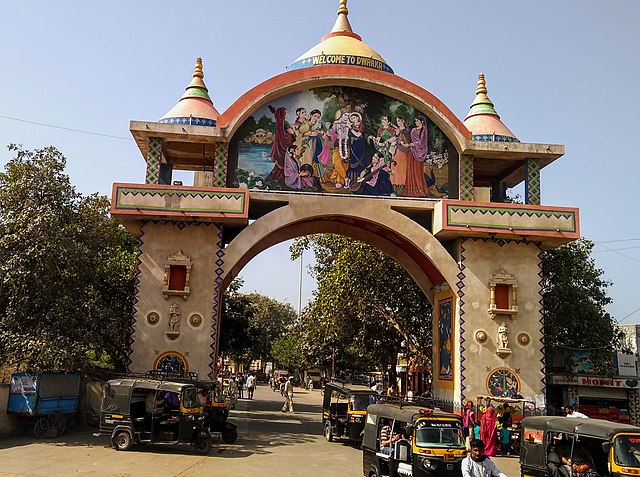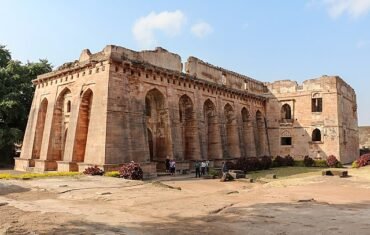Dwarka is a town and a shrine in the Devbhumi Dwarka district of Gujarat, India. It is one of the four sites in India’s Char Dham pilgrimage and is also part of India’s Chota Char Dham pilgrimage circuit. It is dedicated to Lord Krishna, who is worshipped here as Dwarkadhish or the king of Dwarka. The town is located on the western shore of the Okhamandal Peninsula, on the right bank of the Gomti river, at the mouth of the Gulf of Kutch facing the Arabian Sea. The town lies on the site of the ancient kingdom of Krishna, which is believed to have been submerged under the sea after his death.
Location of Dwarka Temple
The Dwarka temple is about 450 km (280 mi) from Ahmedabad city, which is well connected by flights, trains and buses from various cities in India. The temple can also be reached by road from nearby towns such as Jamnagar, Rajkot and Porbandar. The temple is located on the Gomti Ghat, which is a sacred bathing place for the pilgrims. The temple offers a splendid view of the river and the sea.
Timing of Dwarka Temple

The Dwarka temple is open for darshan (viewing) from 6:00 am to 9:30 pm every day. The temple has five aartis (rituals) daily: at 6:30 am, 10:30 am, 5:00 pm, 7:30 pm and 8:30 pm. The temple also has a special aarti called Mangala Aarti, which is performed at 6:00 am using lamps and incense. This aarti is considered to be very sacred and auspicious, as it symbolizes the awakening of Krishna and his consort Rukmini. The temple charges a nominal fee for entry and photography.
Rituals of Dwarka Temple

The Dwarka temple has various rituals and ceremonies that are performed by the priests and devotees throughout the year. Some of the main rituals are:
- Abhishek: This is the ritual of bathing the idol of Krishna with water, milk, honey, curd, ghee and other substances. This is done to express devotion and gratitude to Krishna and to seek his blessings. Devotees can perform abhishek by themselves or by booking online through the temple website.
- Janmashtami: This is the festival that celebrates the birth anniversary of Krishna. It falls on the eighth day of the dark fortnight in the month of Bhadrapada (August–September). On this day, the temple is decorated with flowers, lights and flags. Devotees throng to the temple to offer prayers, sing bhajans (devotional songs) and dance in joy. The idol of Krishna is adorned with new clothes and ornaments. A special puja (worship) is performed at midnight, which is believed to be the exact time of Krishna’s birth.
- Rath Yatra: This is the festival that commemorates the journey of Krishna from Dwarka to Kurukshetra for the Mahabharata war. It falls on the second day of the bright fortnight in the month of Ashadha (June–July). On this day, a grand procession of chariots carrying the idols of Krishna, Balarama (his brother) and Subhadra (his sister) is taken out from the temple to a nearby place called Sudama Setu. Devotees pull the chariots with ropes and chant slogans in praise of Krishna.
Importance of Dwarka Temple

The Dwarka temple is considered one of the most important pilgrimage sites for Hindus, especially for Vaishnavites (followers of Vishnu). The temple has a long and rich history, with evidence of its existence dating back to more than 2,500 years. The temple has been visited and praised by many saints, poets and kings, such as Adi Shankaracharya, Narsinh Mehta, Mirabai, Vallabhacharya and Akbar.
The Dwarka temple is believed to be the place where Krishna established his kingdom after he left Mathura to escape from his uncle Kansa’s tyranny. The temple is also believed to be the place where Krishna performed many miracles and leelas (divine acts) such as lifting Govardhan hill, killing demons like Kalia and Jarasandha, playing the flute and dancing with the gopis (cowherd girls). The temple is also believed to be the place where Krishna gave his famous discourse on the Bhagavad Gita (the sacred scripture of Hinduism) to Arjuna (his friend and disciple) on the eve of the Mahabharata war.
The Dwarka temple is a symbol of faith, power and devotion for millions of Hindus across the world. The temple attracts thousands of pilgrims and tourists every year, who come to seek the blessings of Krishna and to witness the beauty and history of the temple.
Significance of Dwarka Temple

The Dwarka temple has a great significance for Hindus, as it represents one of the aspects of Vishnu, the supreme god of Hinduism. Vishnu is known by many names and forms, such as Narayana (the lord of the universe), Rama (the ideal king), Krishna (the playful lover), Narasimha (the protector), Vamana (the dwarf), Matsya (the fish), Kurma (the tortoise), Varaha (the boar), and many more. Vishnu is also known as Dwarkadhish or the king of Dwarka.
Dwarkadhish is the aspect of Vishnu that symbolizes love and joy. He is the lord who delights his devotees with his charm and grace. He is the lord who protects and guides his devotees with his wisdom and compassion. He is the lord who bestows happiness and prosperity to his devotees, who worship him with love and devotion. He is the lord who rules over Dwarka, which is considered to be a city of gold and jewels.
The Dwarka temple is dedicated to Vishnu as Dwarkadhish, who is worshipped as the giver of love, joy and prosperity. The temple is also dedicated to Vishnu as Jyotirlinga, which means “the linga (symbol) of light”. A Jyotirlinga is a representation of Vishnu’s infinite power and presence, which can be seen and felt by his devotees. A Jyotirlinga is also a manifestation of Vishnu’s grace and compassion, which can heal and transform his devotees.
The Dwarka temple is one of the four sites in India’s Char Dham pilgrimage, which are considered to be the most sacred shrines of Hinduism. The other three sites are Badrinath (in Uttarakhand), Jagannath Puri (in Odisha) and Rameswaram (in Tamil Nadu). These four sites are believed to be the abodes of Vishnu in his four different forms: Badrinatha (the lord of Badri), Jagannath (the lord of the universe), Rameshwara (the lord of Rama) and Dwarkadhish (the lord of Dwarka). By visiting and worshipping these four sites, devotees can experience the various facets of Vishnu’s glory and benevolence.
FAQ’s
How to reach Dwarka temple?
The Dwarka temple can be reached by road, rail or air. The nearest airport is Jamnagar airport, which is about 137 km (85 mi) away from the temple. The nearest railway station is Dwarka railway station, which is about 2 km (1.2 mi) away from the temple. The temple can also be reached by road from nearby towns such as Jamnagar, Rajkot and Porbandar.
When is the best time to visit Dwarka temple?
The best time to visit Dwarka temple is from October to March, when the weather is pleasant and comfortable. The temple can also be visited during festivals such as Janmashtami, Rath Yatra, Diwali and Holi, when the temple is decorated and celebrated with great fervor and enthusiasm.
What are the other attractions near Dwarka temple?
There are many other attractions near Dwarka temple that can be explored by the visitors. Some of them are:
Rukmini Devi Temple: This is a temple dedicated to Rukmini Devi, who was Krishna’s chief consort and queen. It is located about 2 km (1.2 mi) from Dwarka temple. It is believed that Krishna married Rukmini here after abducting her from her wedding with another king.
Bet Dwarka: This is an island in the Arabian Sea that lies about 30 km (19 mi) from Dwarka. It is believed that Krishna lived here with his family and friends. It has many temples dedicated to Krishna, Rukmini, Balarama, Lakshmi Narayan and other deities.
Nageshwar Jyotirlinga: This is a temple dedicated to Shiva as Nageshwar or the lord of snakes.
Conclusion
The Dwarka temple is a sacred and scenic temple that showcases the power and devotion of Hinduism. The temple is a testimony of the faith and courage of the Hindus, who have preserved and maintained the temple despite several challenges and calamities. The temple is a source of inspiration and solace for millions of pilgrims and tourists, who come to seek the blessings of Krishna and to witness the beauty and history of the temple. The Dwarka temple is not just a temple, but a living legend that embodies the spirit and essence of Hinduism.











